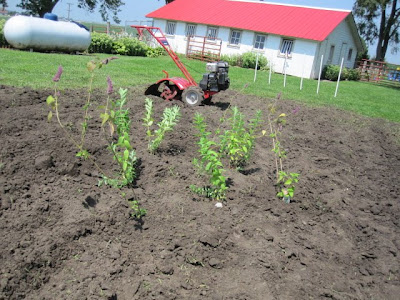The 'sink hole' closest to our house, and right out our South door seemed to be the worst. When it rained, which has been more often than not this year, we ended up with standing water. This really HAD to stop! Not that the ducks cared! They liked having a little pond for a day or so.
A few weeks ago, Bill went with me to a Master Garden 'work shop' in which a rain garden was constructed. Rain gardens are used to stop erosion, prevent unnecessary water run off and filter water naturally. The project was located in Cedar Rapids, at a home that had suffered some flood damage in 2008. The owner wanted a pretty garden, with native plants and that would help prevent excess rain water from entering the sewer system.
This project lead to a discussion about fixing our own 'standing water problem', and thoughts of adding our own rain garden. When I came upon some Native Iowa Plants on sale, it was "GAME ON"!!
When selecting plant for a rain garden, you would like them to have a deep fibrous root system. This will help filter more water. Since we used plants Native to our area, they should be able to handle our normal 'living' conditions.
The first step in our project was to haul in some soil, aka = dirt! In stepped the world's best neighbor, Alan!! He brought over his tractor and bucket and took soil from our cattle yard and filled in the 'hole'. It took 10 buckets loads to get it level.
Then we used Jeff's tiller to work up the soil. Okay, Bill used Jeff's tiller. I just pointed and directed a lot! Here's the first plants that went in. 4 - Great St. John's Wort (yellow flowers) and 4 - Anise Hyssop (purple flowers). I LOVE Anise Candy, so thought this would be a great addition to the garden.
Other plants added - Indian Paintbrush, Silky Aster, Rattlesnake Master, Purple Cone Flower (along with Sundown - red - and Sunrise - yellow - cone flowers), Swamp Milkweed, Blazing Star, Wild Lupine, Mist Flower, False Blue Indigo, and Sweet Black-Eyed Susan.

These poor plants were so root bound.
I did several cross cuttings in order to open their root balls up.
I'm hoping they will be able to spread naturally and overcome
there tight conditions. Time will tell!
Being Natives, they should be hardy enough.
I did several cross cuttings in order to open their root balls up.
I'm hoping they will be able to spread naturally and overcome
there tight conditions. Time will tell!
Being Natives, they should be hardy enough.

BUGS!!!
Ugh, the False Blue Indigo had mites!
No wonder it looked so sad.
I hand picked them off and I'll watch for more.
Ugh, the False Blue Indigo had mites!
No wonder it looked so sad.
I hand picked them off and I'll watch for more.

Some mulch was added, along grass seed and straw.
The fence is required to keep the birds out!
Cougar was walking the fence line and gave
chase to a couple of hens.
GOOD BOY COUGAR!
It's going to take a year or two for it to fill in.
The fence is required to keep the birds out!
Cougar was walking the fence line and gave
chase to a couple of hens.
GOOD BOY COUGAR!
It's going to take a year or two for it to fill in.

Birds at the perimeter!
They ALWAYS know when food is available.
We did have a few 'fence breaches', we'll need to keep an
eye out for bird invasions.
At least the ducks seemed to be sober!
Jeff thought it would be funny to bring out some
fermented fruit trimming.
The ducks were a little 'sauced' on Saturday.






2 comments:
Awesome idea!!
That is very cool. Will be fun to watch it grow. Phoenix would have loved to help Bill dig. Jamie, too!
Post a Comment